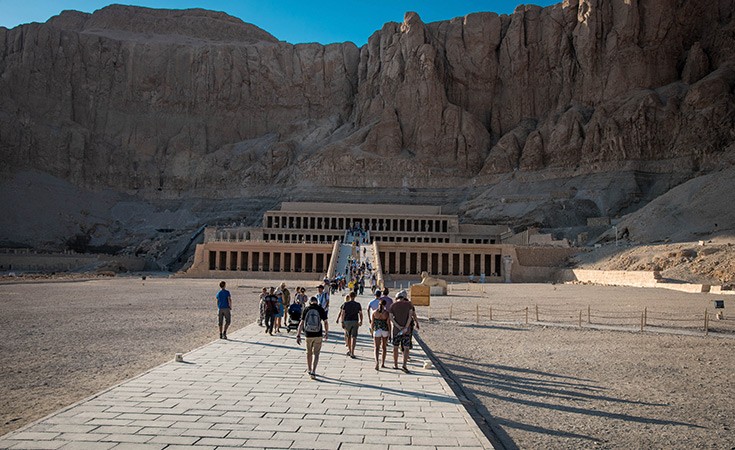
Al Deir Al Bahari Temple, also known as the temple of the queen Hatshepsut, is one of the most beautiful temples in Luxor and definitely a must-see attraction.
Hatshepsut was the fifth pharaoh of the 18th dynasty, daughter of Pharaoh Thutmosis I. Hatshepsut aspired to obtain the position of the sovereign of Egypt and to legitimize her ascension to the throne, and she undertook the most unprecedented propaganda campaign in the history of Ancient Egypt. She declared herself as the daughter of the god Amon-Ra, so that no one could think about removing her from the throne of Egypt. She rebuilt numerous monuments destroyed by the fury of the Hyksos, but despite this, after her death, her successor Thutmosis III decided to proceed with “damnatio memoriae”, erasing Hatshepsut’s memory forever (he destroyed the temples and sculptures that Hatshepsut has built during her reign, because of his complex relationship with the queen Hatshepsut).
The most important monument belonging to this sovereign is located in the modern Deir el-Bahari, set against the backdrop of a rocky hill spanned by water and beaten by hot winds for millions of years.
Hatshepsut’s architect, Senenmut created a real work of art, realizing that only long horizontal lines could give so much grandeur and magnificence to the overlying vertical lines of the background.
But the greatest innovation lies in the fact that god Amon was granted a pre-eminent position in the temple and that is the reason why the temple was erected in perfect axial alignment with the temple of Amon at Karnak. In fact, if the main axis of the temple of Hatshepsut was extended 5 km to the east, towards Karnak, the gap with the axis of the temple of Amon-Ra would have been less than 100m.
The Egyptians called this temple "Djeser-Djeseru" which means “A Saint among the Saints".
The first ruler to exploit this natural rocky amphitheater was Mentuhotep II (dynasty XI) who chose it as the site for his funerary temple. In the New Kingdom, Queen Hatshepsut built her funerary temple as well, taking over the terraced structure of the temple of Mentuhotep II and expanding it further. Later, Thutmose III built a temple dedicated to the god Amon in the middle of the two funerary complexes, which was very similar to the monument of Hatshepsut. In the Ptolemaic period, the temple of the queen was modified and expanded. Finally, the Copts built a monastery inside, called the "monastery of the north", from which the Arabic toponym "Deir el-Bahari" is derived from. Copts additionally removed the “pagan” statues and decorations.
The temple owes its current appearance to the restoration and reconstruction by a Polish-Egyptian mission active on this site since 1961, which has been mostly able to restore the monument to its former glory.
Today, modern operas are performed here.
 Ticket price for Al Deir Al Bahari Temple
Ticket price for Al Deir Al Bahari Temple
The regular ticket price is 100 EGP.
 Working hours of Al Deir Al Bahari Temple
Working hours of Al Deir Al Bahari Temple
Temple is open every day from 6am to 5pm.